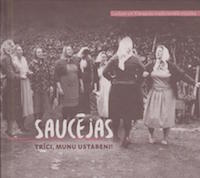The Latvian national record label Skani has already released a number of classical music CDs that have highlighted many talented Latvian performers and composers, and, being a state funded label, have the artistic freedom to present a broad range of artists. Alongside albums by well-known artists like Egils Siliņš and the Latvian Radio Choir, the label can also present recordings by artists that are, comparatively less well-known, but no less talented or significant.
A noteworthy recent release from Skani is Rīgas Doms. Ērģeles diviem (or Organ Duo at Riga Cathedral) which features the organ duo of Ilze Reine and Aigars Reinis performing the organ of the Riga Cathedral. Dating from 1883/84, the organ is not only one of the largest, but also one of the most significant organs in Europe, and has inspired listeners and performers for many generations.
Organ performance, which involves not just hands but feet as well, is challenging, and two playing the same organ is certainly complex, but Reine and Reinis, who have been performing together since 2009, offer a resonant and diverse collection of performances of works from the 19th, 20th and 21st centuries by both Latvian and European composers.
British composer John Rutter, though perhaps best known for his choral works, composed ‘Variations on an Easter Theme’ which premiered in 1983. The work, which is based on the 15th century song ‘O filii et Filiae’, presents seven variations of the theme, incorporating modern elements and interpretations. The Renaissance era song is presented in various aspects, and each variation is distinct, and uses the full spectrum of organ sounds. Throughout the varied performances, Reine and Reinis accent both the individuality of each variation, as well as the core theme, blending the ancient and the modern in a distinctive performance.
‘Bērnības ainava’ (Landscape of Childhood), is a work by Latvian composer Imants Zemzaris, and, as its title would indicate, is a slightly sentimental, quiet work. Though melodic and peaceful, there are still undertones of sadness. Near the end there is an almost imperceptible fragment from the melody of the children’s game ‘Kas dārzā’. Though the work is brief (less than five minutes in length), it still captures much of the essence of childhood.
‘Fugue and Fantasy’ by Latvian composer Ilona Breģe was written specifically for the organ duo of Ilze Reine and Aigars Reinis, and to be played on the Riga Cathedral organ, as a showcase for the broad sonic possibilities of the instrument. From thundering basses to quiet, bell-like sounds, the composition covers a range of emotions and feelings, and Reine and Reinis adeptly bring forth all the nuances of this multi-faceted work.
The best known work on this collection is Czech composer Bedřich Smetana’s symphonic poem Vitava (also known by its German name – ‘The Moldau’). Though originally a work for symphonic orchestra, Smetana also created a version for two pianos, and this is the basis for this arrangement. This performance retains the mystical dreamy quality of the original work, and even presents new aspects. In fact, the sounds of the keys being played may even remind the listener of a river lapping against its banks. The performance also shows how one organ can still retain many of the different qualities and timbres of a symphony orchestra. The majestic performance of Reine and Reinis not only shows the skill of the organists themselves, but the vast possibilities of the Riga Cathedral organ.
The CD booklet has extensive notes in Latvian and English on the performers, composers, works, and even the Riga Cathedral Organ (mentioning, among other things, that the organ has 124 registers, 4 manuals, and 6718 pipes).
Rīgas Doms. Ērģeles diviem, besides being a compelling collection of organ works, also serves as yet another example of why the Riga Cathedral organ is one of the most famous organs in the world. The accomplished organ duo of Ilze Reine and Aigars Reinis display the broad range of sounds and timbres of the organ on this varied collection, another excellent release from the Skani record label.
For further information, please visit the Skani website.
Rīgas Doms. Ērģeles diviem.
Ilze Reine un Aigars Reinis
Skani, LMIC/SKANI 047, 2016
Track listing:
- John Rutter – Variations on an Easter Theme
Gustav Merkel – Sonata op. 30 d-moll - Allegro moderato
- Adagio
- Allegro con fuoco
- Imants Zemzaris – Bērnības ainava
- Ilona Breģe – Fugue and Fantasy C-dur
- Bedřich Smetana – Symphonic Poem Vitava
- Aivars Kalējs – Toccata C-dur





